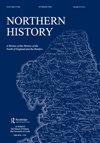ALAN BROOKE, Nature’s Missionary: Seth Lister Mosley – Naturalist, Museum Curator and Mystic 1848–1929 (Huddersfield: Huddersfield Local History Society, 2022. £15 [paperback]. 264 pages [Inc. 16 pages of full-colour plates]. ISBN: 9780992984151)
IF 0.2
3区 历史学
Q2 HISTORY
引用次数: 0
Abstract
(p.108) but they’re easy to work around. The book is well illustrated with Brears’ characteristic hand drawn pictures. In general, these work well, for his forensic eye for detail and skill as a draughtsman means that they are often clearer than any photograph could be. At times, though the lack of alternative can be frustrating, especially when a visual source is described in the text. I would have loved to have seen the actual photograph of Leslie Feather’s bakery (p.43). One of the great strengths of Brears’ writing is his lack of patience with romanticising the past, especially when this creeps into object interpretation. His dry takedown of the idea of pottery beer containers as having been ‘cider jars’ should have anyone who has unthinkingly subscribed to the idea wincing. He is clear-eyed and matter of fact when describing the aching poverty of the area for much of history, and of the consequences of this for the development of an identifiably regional cuisine. The final two chapters cover the rhythms of the year, as seen through food, and the corresponding way in which lives were marked through cakes and biscuits—very much in the vein of Mary Douglas but highly focussed on the way in which food was used in this place and by these people. They manage to bring together the themes and specifics of the rest of the book neatly. Separate indexes of people, places and recipes are provided. Overall, this does exactly what it says on the tin. It’s a reminder of how useful small-scale publications are, fitting nicely into the wider landscape of food history, as well as being fascinating as a study in its own right.艾伦·布鲁克,《自然的传教士:赛斯·李斯特·莫斯利——博物学家、博物馆馆长和神秘主义者1848-1929》(哈德斯菲尔德:哈德斯菲尔德地方历史学会,2022年)。£15(平装)。264页[包括16页全彩版]。ISBN: 9780992984151)
(第108页)但是他们很容易相处。这本书用Brears特有的手绘画作了很好的插图。总的来说,这些作品效果很好,因为他对细节的法医眼光和绘图员的技能意味着它们通常比任何照片都清晰。尽管有时缺乏替代品可能会令人沮丧,尤其是当文本中描述了视觉来源时。我很想看到莱斯利·费瑟(Leslie Feather)面包店的真实照片(第43页)。Brears写作的最大优点之一是他对浪漫化过去缺乏耐心,尤其是当这一点逐渐渗透到物体解读中时。他把陶瓷啤酒容器的想法说成是“苹果酒罐”,这应该会让那些不假思索地赞同这个想法的人退缩。他在描述该地区历史上大部分时间的痛苦贫困,以及这对发展一种可识别的地区美食的影响时,目光清晰,实事求是。最后两章涵盖了从食物中看到的一年的节奏,以及通过蛋糕和饼干标记生活的相应方式——非常符合玛丽·道格拉斯的风格,但高度关注这个地方和这些人使用食物的方式。他们设法将本书其余部分的主题和细节巧妙地结合在一起。提供了人员、地点和食谱的单独索引。总的来说,这正是罐头上写的。这提醒我们,小规模出版物是多么有用,很好地融入了更广泛的食品史领域,而且作为一项研究本身也很吸引人。
本文章由计算机程序翻译,如有差异,请以英文原文为准。
求助全文
约1分钟内获得全文
求助全文
来源期刊

Northern History
Multiple-
CiteScore
0.20
自引率
33.30%
发文量
37
期刊介绍:
Northern History was the first regional historical journal. Produced since 1966 under the auspices of the School of History, University of Leeds, its purpose is to publish scholarly work on the history of the seven historic Northern counties of England: Cheshire, Cumberland, Durham, Lancashire, Northumberland, Westmorland and Yorkshire. Since it was launched it has always been a refereed journal, attracting articles on Northern subjects from historians in many parts of the world.
 求助内容:
求助内容: 应助结果提醒方式:
应助结果提醒方式:


